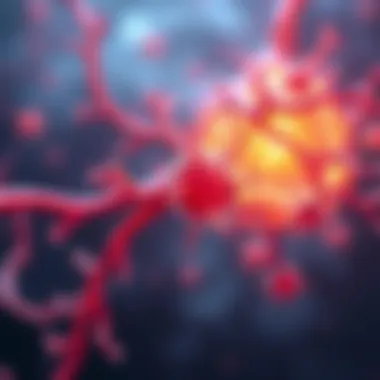Comprehensive Guide to Graft versus Host Disease


Intro
Graft versus Host Disease (GvHD) represents a significant concern in the sphere of transplant medicine. This condition arises when immune cells from a donor, such as those derived from a stem cell or bone marrow transplant, begin to attack the tissues of the recipient's body. The underlying mechanisms that lead to this reaction are complex and multifaceted, often instigating a cascade of immunological events that can severely affect patient prognosis.
As transplant techniques continue to advance, an understanding of GvHD becomes increasingly essential. Patients and caregivers must stay well-informed about what GvHD entails, the risks involved, and the potential for successful treatments. This article aims to dissect the elements of GvHD, delve into its mechanisms, and discuss clinical practices, making it a vital read for students, researchers, educators, and professionals in the medical field.
Research Background
Overview of the scientific problem addressed
GvHD poses a unique set of challenges in the realm of transplantations. The phenomenon occurs when the transplanted immune cells perceive the recipient’s body as foreign, launching an immune response. This response can manifest in various ways, affecting skin, liver, gastrointestinal tract, and other organs. The significance of GvHD extends beyond immediate patient comfort; it can influence long-term transplant success rates. Figures suggest that about 30 to 50 percent of bone marrow transplant patients will develop acute GvHD, emphasizing the necessity to comprehend the immunological underpinnings of this disease.
Historical context and previous studies
Historically, GvHD was first recognized in the early 20th century as researchers began to understand the dynamics of immune cells in transplant scenarios. Initial observations led to more rigorous studies aimed at uncovering the intricate cat-and-mouse game between donor immune cells and the recipient’s immune system. It was not until the 1980s that significant strides were made, with clinical studies examining not just the prevalence of GvHD, but also its various grades and manifestations, giving rise to a standardized classification system that continues to inform therapeutic decisions today.
Findings and Discussion
Key results of the research
Recent research has elucidated various factors that may trigger GvHD, such as the HLA typing of donor and recipient, the degree of immunosuppression therapy utilized, and specific genetic variations within both parties. Studies utilizing mouse models have also provided insights into how certain cytokines modulate the immune response during transplant. These findings highlight a direction for tailored therapeutic approaches that may prevent or mitigate the severity of GvHD.
Interpretation of the findings
The implications of this research stretch far and wide. Understanding the risk factors associated with GvHD allows for better prediction models, which can inform pre-transplant assessments. Furthermore, identifying specific immune pathways can lead to targeted therapies aiming to inhibit the adverse effects of donor cells while maintaining their beneficial immune properties against infections or malignancies. Current therapeutic modalities range from corticosteroids to more experimental strategies, indicating a pivot towards more personalized treatment protocols.
As the understanding of GvHD evolves, so too does the standard of care in transplant medicine. It’s crucial for all stakeholders – medical professionals, patients, and researchers – to engage in conversations grounded in the latest findings to ensure optimal outcomes.
Preamble to Graft versus Host Disease
Graft versus Host Disease (GvHD) is a pivotal topic within the realm of transplant medicine, significantly impacting both donor and recipient post-transplant outcomes. Understanding this condition is not just for the medical professionals; it is crucial for students and researchers who are navigating through the complex landscape of immunology. By delving into GvHD, one can appreciate the delicate balance the immune system maintains, and how disruptions can lead to severe consequences.
Recognized as a significant complication post-stem cell or bone marrow transplantation, GvHD occurs when the immune cells from the donor graft recognize the recipient’s tissues as foreign and mount an immune response. This phenomenon underscores the complexities involved in transplant procedures and the necessity of careful donor-recipient matching.
Importance of Understanding GvHD
The relevance of exploring GvHD cannot be overstated. With advancements in transplant procedures and therapies, patients are increasingly surviving but may face the daunting aftermath of GvHD. The implications extend beyond immediate healthcare; they touch upon quality of life, long-term health, and resource allocations in healthcare settings. Understanding GvHD allows for a nuanced approach to patient care which encompasses not only the biological mechanisms but also the psychological effects on patients and families.
Benefits of a Comprehensive Overview
A thorough grasp of GvHD provides valuable insights into:
- Patient Management: Healthcare professionals can tailor monitoring and treatment strategies to minimize the risk of developing GvHD.
- Research Directions: For academicians and students, understanding GvHD leads to meaningful contributions in research, potentially influencing future therapeutic innovations.
- Interdisciplinary Collaboration: GvHD promotes dialogue between various medical disciplines—including immunology, oncology, and pharmacology—encouraging collaborative approaches to complex problems.
Immunological Basis of GvHD
Understanding the immunological basis of Graft versus Host Disease (GvHD) is crucial for comprehending how donor immune cells can react inappropriately against recipient tissues. The underlying mechanisms deconstruct the complexities of immune interactions that lead to GvHD following transplantation. Grasping these concepts can guide the development of targeted therapies and improve outcomes for patients undergoing stem cell or bone marrow transplants.
Immune System Components Involved


In exploring the immune system's role in GvHD, three main components emerge as pivotal: T cells, antigen-presenting cells, and the major histocompatibility complex (MHC). Each of these elements plays a distinct role in the initiation and perpetuation of the immunological conflict that characterizes GvHD.
T Cells
When it comes to T cells, the crux of their operation lies in their ability to recognize foreign antigens. These cells are like soldiers in one’s body, patrolling for potential threats. In GvHD, T cells derived from the donor recognize the recipient’s tissues as foreign and launch an attack. This aggressive behavior is the hallmark of GvHD.
Moreover, T cells are characterized by their diverse receptor population, which allows them to identify various antigens. This adaptive feature is beneficial as it equips them to tackle different types of pathogens. However, this same versatility can result in detrimental effects when T cells misidentify normal tissues during a transplant.
Antigen-Presenting Cells
Antigen-presenting cells (APCs), such as dendritic cells, play a critical role in the activation of T cells. They shine in their capacity to process and present antigens to T cells, effectively serving as a bridge between innate and adaptive immunity. Within the context of GvHD, the interaction between APCs and T cells becomes particularly important.
APCs enhance T cell activation when they present recipient tissue antigens, persuading donor T cells that these tissues are indeed a foe worth engaging. The key characteristic of APCs lies in their ability to shape the immune response. This adaptability is beneficial because it provides a rapid response to infections, but in GvHD, the over-activation of T cells leads to tissue damage that complicates recovery.
Major Histocompatibility Complex
The major histocompatibility complex (MHC) is a collection of molecules displayed on cell surfaces, crucial for immune system recognition. The MHC's primary function is to present peptide fragments for T cells to analyze. In GvHD, the MHC becomes a focal point of conflict, as mismatches between donor and recipient can provoke severe immune responses.
A significant aspect of MHC is its polymorphic nature, which allows a diverse range of antigens to be presented. This versatility makes it a popular topic of research, especially in transplant settings. However, the dissimilarities in MHC between donor and recipient are the root causes of prolonged immune responses, leading to acute or chronic GvHD symptoms.
Mechanisms of Tissue Damage
The mechanisms of tissue damage in GvHD are multi-faceted and can often be devastating. The immune response triggered by T cells, guided by APCs and influenced by MHC, leads to a cascade of inflammatory processes that result in tissue injury.
In GvHD, the complexities of immune signaling initiate a furious offensive where target tissues—such as skin, liver, and intestines—suffer damage from heightened immune activity. This immune-mediated destruction is compounded by factors like the presence of cytokines, which can exacerbate inflammation and lead to significant morbidity in affected individuals. Understanding these mechanisms lays the groundwork for devising effective treatments aimed at mitigating tissue damage, which is crucial for improving patient outcomes following transplantation.
"A thorough grasp of the immunological intricacies of GvHD is the first step for any healthcare professional working in transplant medicine."
By dissecting the involvement of T cells, antigen-presenting cells, and the major histocompatibility complex, one can appreciate the delicate balance within the immune system that can tip into adverse reactions like GvHD, shedding light on the significance of careful donor-recipient matching and ongoing research in this domain.
Types of Graft versus Host Disease
Understanding the types of graft versus host disease (GvHD) is paramount when delving into the complexities of this immunological condition. GvHD manifests in two primary forms: acute and chronic. Each type presents unique challenges and considerations in clinical approaches. Knowing the differentiators between acute and chronic GvHD helps clinicians anticipate patient needs, tailor treatments, and improve outcomes. Furthermore, recognizing risk factors associated with each type can aid in preventative strategies, making this distinction both beneficial and crucial for effective transplant management.
Acute GvHD
Clinical Presentation
When it comes to acute GvHD, the clinical presentation often serves as the first sign of trouble brewing post-transplant. Typically occurring within the first 100 days after the stem cell or bone marrow transplant, acute GvHD can manifest in several distinct forms, with the skin, liver, and gastrointestinal tract commonly affected. Notably, the skin may develop a rash resembling sunburn, and patients can experience abdominal pain or diarrhea that can lead to dehydration.
The key characteristic here is the timing and scope of symptoms, marking it as a significant focus for this discussion. This type of GvHD can escalate quickly, making early recognition essential for timely intervention. On the flip side, the unique feature of acute clinical presentation rests in the potential for immediate and effective treatment if caught in the early stages. However, missing these signs can lead to severe complications, emphasizing the need for vigilance.
Pathophysiology
In terms of pathophysiology, acute GvHD arises from the differential immunological responses triggered after a transplant. Essentially, T cells from the donor (the graft) identify the recipient's tissues as foreign and initiate an aggressive attack. The key aspect here is the activation of these T cells, which initiate an immune cascade that results in significant tissue damage.
Moreover, the unique feature of acute GvHD's pathophysiological mechanism lies in its rapid onset and response to therapy. In many cases, recognizing this mechanism allows for targeted immunosuppressive treatments, which are critical for managing the disease's severity. However, this also underscores a potential disadvantage; if treatments are not effectively monitored, a delicate balance must be maintained to avoid compromising the overall immune system too drastically.
Risk Factors
Risk factors associated with acute GvHD contribute significantly to an understanding of and managing this condition. Factors such as the degree of HLA mismatch between donor and recipient and the intensity of the conditioning regimen can increase the likelihood of developing acute GvHD. The key characteristic here is that awareness of these risk factors can inform pre-transplant evaluations and post-transplant monitoring.
The unique feature of recognizing these risk factors lies in the proactive measures that can be adopted in clinical practice. For instance, identifying a high-risk patient can prompt closer monitoring and preemptive therapy, which can greatly improve outcomes. Yet, focusing too heavily on these risk factors without comprehensive patient assessments can lead to an oversight of the individual nuances that each case presents.
Chronic GvHD


Clinical Features
Chronic GvHD, on the other hand, poses a different set of challenges. This form typically arises more than 100 days after transplantation and can manifest as a complex syndrome resembling autoimmune diseases. Patients often experience symptoms such as dry mouth, skin changes, and lung issues. The key characteristic of chronic GvHD is its prolonged nature, leading to more insidious symptoms over time. This makes it a particularly difficult aspect to manage, as patients may not be as acutely aware of its gradual onset.
The unique feature of recognizing clinical features of chronic GvHD emphasizes the need for long-term follow-up in transplant patients. Early identification of symptoms can be vital to implementing supportive therapies and avoiding prolonged suffering. However, it can also lead to challenges in diagnosis, as chronic symptoms may be attributed to other conditions, complicating treatment strategies.
Long-term Complications
The long-term complications associated with chronic GvHD are another substantial concern. These complications can significantly affect a patient's quality of life and may include liver dysfunction, irreversible lung damage, or even increased risk of secondary malignancies.
What makes long-term complications so critical is their potential to persist even after the acute phase has passed. This key characteristic creates a necessity for ongoing monitoring and interventions that address both the immediate symptoms and long-term health.
Yet, the unique feature here is that recognizing such complications earlier can lead to more proactive management, potentially decreasing mortality rates. The counterpoint, however, is that long-term management can quickly become overwhelming for both providers and patients, necessitating a careful balance of intervention vs. quality of life considerations.
Diagnosis
Diagnosing GvHD, in both its acute and chronic forms, requires a high level of clinical suspicion and a keen understanding of the transplant history. A combination of clinical evaluations, patient-reported symptoms, and tissue biopsies may assist in this process. The key characteristic of diagnosis lies in its multifaceted approach, encompassing various diagnostic techniques to ensure accurate identification.
The unique feature of the diagnosis of GvHD is the reliance on both objective metrics and subjective patient feedback, which can create a more comprehensive clinical view. However, discrepancies in these reports can create challenges in reaching a consensus regarding the diagnosis, affecting treatment modalities. Thus, an integrative approach—balancing clinical findings with patient narratives—remains paramount.
Clinical Implications of GvHD
Understanding the clinical implications of Graft versus Host Disease (GvHD) is vital for professionals and researchers working in the field of transplant medicine. GvHD poses significant challenges that can impact patient outcomes post-transplant. By grasping the important aspects of diagnosis, monitoring, and treatment strategies, healthcare providers can better navigate the complexities associated with this condition. In turn, this understanding can lead to improved patient survival and quality of life.
Diagnosis and Monitoring
Diagnosing GvHD is a multi-faceted process that often includes clinical evaluation, laboratory tests, and biopsy procedures. Symptoms may vary widely, from skin rashes to gastrointestinal distress, making it critical to have a high index of suspicion, especially in the early stages. Multiple assessments are typically carried out, including visually examining the skin and mucosal surfaces along with assessing organ function.
Monitoring of GvHD is crucial and often includes the following methodologies:
- Regular physical examinations: Clinicians check for any new symptoms or signs of the disease.
- Biomarker analysis: Blood tests may reveal specific markers that indicate the presence or severity of GvHD.
- Imaging studies: These can provide insights into organ involvement, particularly in the lungs or liver.
Establishing a precise diagnosis as soon as possible helps in tailoring the management plan effectively, thereby improving outcomes.
Treatment Strategies
Treatment for GvHD generally falls into two categories: immunosuppressive therapies and supportive care. Both strategies have their unique roles and effectiveness in handling this complex condition.
Immunosuppressive Therapies
Immunosuppressive therapies serve a critical function in the management of GvHD. These treatments aim to suppress the alloreactive donor T cells that attack the recipient's tissues. Common options include corticosteroids and other agents like cyclosporine and tacrolimus.
The key characteristic of immunosuppressive therapies lies in their ability to modulate the immune response. Corticosteroids, for instance, are often the first line of defense due to their potent anti-inflammatory properties. This makes them a popular choice for quick relief of symptoms. However, the use of these agents is not without its downsides; prolonged use can lead to side effects such as increased infection risks and organ dysfunction.
A unique feature of these therapies is their dose-dependent nature. That means the effectiveness often correlates with how much of the drug is administered. Conversely, too high a dose can lead to complications, making it necessary to find that fine balance. Each patient may respond differently, so therapy needs to be individualized based on their specific circumstances.
Supportive Care
Supportive care plays an indispensable role in managing symptoms and complications arising from GvHD. This approach encompasses a broad spectrum of interventions designed to improve the patient’s comfort and quality of life.


The key characteristic of supportive care is that it is holistic, focusing not only on treating the disease but also on providing relief from symptoms. Options may include pain management, nutritional support, and physical rehabilitation, which can be crucial for patients dealing with chronic GvHD.
A unique aspect of supportive care is its adaptability; it can be tailored to the individual needs of patients. For example, if a patient suffers from severe gastrointestinal symptoms, dietary modifications may substantially improve their quality of life. However, one disadvantage is that supportive care alone may not be enough to address the underlying GvHD, and it should ideally complement immunosuppressive therapies for better outcomes.
"The integration of immunosuppressive therapy with supportive care paints a more comprehensive picture for managing GvHD, addressing both immediate and long-term challenges."
In summary, addressing the clinical implications of GvHD involves a solid understanding of diagnosis, monitoring, and treatment strategies. Through this multifaceted approach, healthcare providers can greatly enhance the management of GvHD, ultimately leading to improved patient outcomes.
Research and Future Directions
Research in Graft versus Host Disease (GvHD) is a critical frontier in transplant medicine. This section will delve into why ongoing research is paramount, touching on the multifaceted impact GvHD has on patients post-transplant. Understanding the dynamics of GvHD can not only improve patient care but also enhance the effectiveness of stem cell and bone marrow transplant protocols.
The quest for knowledge in this field serves several vital purposes:
- Enhancing Patient Outcomes: Continuous research offers hope for better management of GvHD, which can significantly improve the quality of life for patients. Fresh insights into immune responses can influence treatment choices, leading to tailored therapies that align better with individual patient needs.
- Guiding Prevention Strategies: By identifying genetic predispositions and other risk factors linked to GvHD, researchers can play a crucial role in developing preventive measures that minimize the incidence of this condition. Early recognition of at-risk individuals can lead to proactive interventions.
- Stimulating Innovation: Research ignites innovation in therapeutic interventions. Scientific exploration often leads to breakthrough therapies or combination treatments that were previously unthinkable, offering new hope to those affected by GvHD.
Recent Advances in GvHD Research
Recent advancements in GvHD research have brought about groundbreaking revelations. For instance, scientists have recently focused on a deeper understanding of the role of regulatory T cells in the immune system. Regulatory T cells, which keep immune responses in check, could be harnessed to mitigate GvHD.
Moreover, next-generation sequencing techniques are revolutionizing the way we understand cell interactions post-transplant. This technology allows researchers to analyze the genomic variations between donor and recipient. Thus, aiding in predicting and preventing adverse outcomes.
Another significant advancement is the exploration of biomarkers that predict acute GvHD. If clinicians can identify specific biomarkers early, they might tailor treatment more effectively, perhaps even before severe symptoms manifest.
"The future of GvHD management lies in understanding its nuanced biology, opening doors for personalized treatment pathways."
Potential Therapeutic Innovations
Therapeutic innovations for GvHD are continually evolving. Traditional treatment methods, such as corticosteroids and immunosuppressants, do play a significant role, but they can carry a burden of side effects. Therefore, researchers are actively exploring more targeted therapies.
- Monoclonal Antibodies: These have shown promise in selectively targeting immune cells responsible for tissue damage. For example, therapies like anti-thymocyte globulin have already been implemented in clinical settings.
- Cellular Therapies: Adoptive cell transfer methods, utilizing the patient’s own immune cells to combat GvHD, are being developed. This approach holds potential in reprogramming the immune response without additional immunosuppression.
- Small Molecule Inhibitors: Emerging therapies include small molecule drugs that can interfere with the signaling pathways in T cells responsible for initiating GvHD. These therapies represent a shift toward precision medicine in GvHD treatment.
The trajectory of GvHD research is clear: as scientists persist in unraveling this complex immunological challenge, the potential for innovative therapies increases.
For further insights into ongoing work in this area, resources such as ClinicalTrials.gov and the American Society of Hematology can be valuable. These sites feature current studies and emerging therapies that are shaping the field of GvHD management.
Ending
The conclusion serves as a critical component of this article, encapsulating the multifaceted nature of Graft versus Host Disease (GvHD). It provides a final perspective on the complexities surrounding the condition and its implications on patient care and research initiatives. By summarizing the key insights discussed, readers can better grasp the intricate relationship between graft and host, thereby understanding how GvHD impacts individuals post-transplant.
Summary of Key Points
Wrapping up, it's important to highlight several essential points regarding GvHD:
- GvHD arises when donor immune cells attack the recipient's tissues, leading to acute or chronic manifestations.
- The immunological basis involves a nuanced interplay of immune components like T cells and antigen-presenting cells.
- Diagnosis relies on clinical presentations and specific risk factors associated with patient demographics.
- Treatment strategies range from immunosuppressive therapies to supportive care, which aim to alleviate symptoms and improve quality of life.
- Continuous research is vital to uncover newer, effective interventions and understand GvHD's long-term implications.
This summary underscores the necessity of an ongoing dialogue within the medical and research communities about GvHD, driving home the fact that while strides have been made, significant challenges remain.
Importance of Continued Research
Continued research into GvHD remains imperative for numerous reasons:
- Understanding Mechanisms: Delving deeper into the underlying mechanisms can illuminate why some patients develop severe GvHD while others do not. This knowledge can facilitate personalized treatment approaches.
- Innovative Therapies: There’s a pressing need for the development of novel therapeutic options. Current treatments, while helpful, often come with significant side effects and variable success rates.
- Informing Clinical Practice: Research outcomes can directly influence clinical guidelines, ensuring that healthcare professionals are equipped with the latest, most effective strategies in managing GvHD.
- Enhancing Patient Outcomes: Ultimately, the overarching goal of continued research is to improve the overall prognosis for patients, reducing the incidence and severity of GvHD.
In summary, as our understanding of graft versus host interactions evolves, so too should our commitment to ongoing studies and advancements in therapeutic approaches. Without such dedication, the shadows of uncertainty surrounding GvHD may continue to loom large over patient care.







